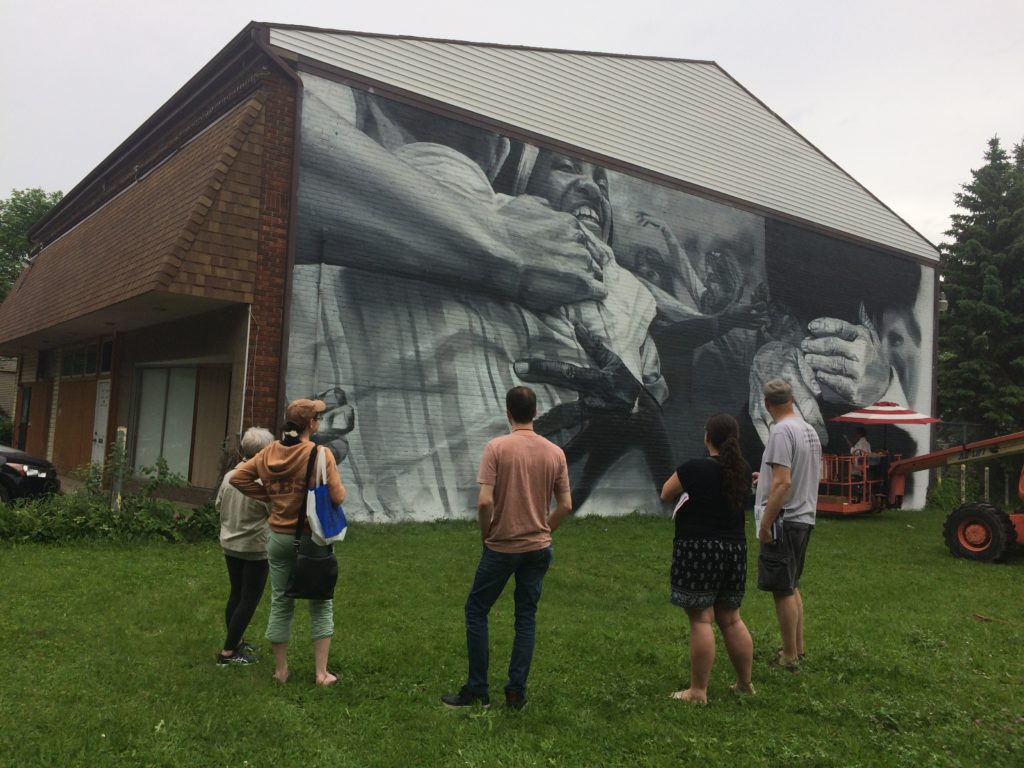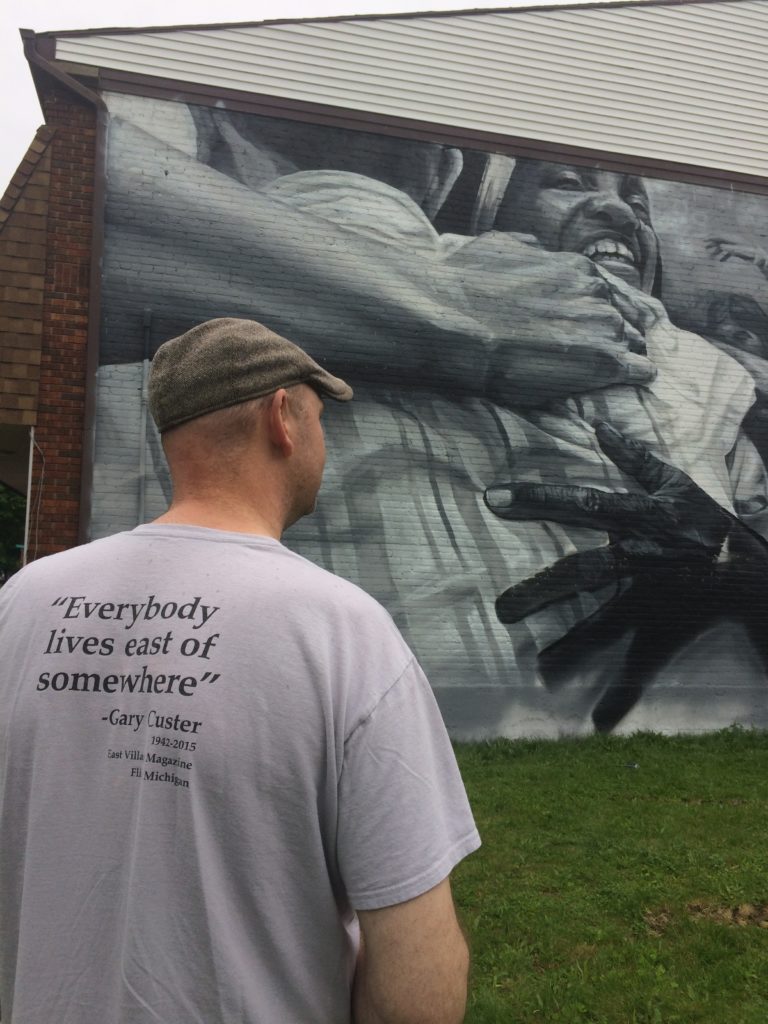By Harold C. Ford
“Basically, the idea behind the mural is we don’t need to hate each other.”
–Murales Lian, muralist
Flint’s Central Park Neighborhood Association (CPNA) will celebrate the completion of a new mural on the wall of the East Village Magazine (EVM) building, 720 E. Second St., by artist Murales Lian on Thursday, June 13 with free food, music, and conversation in the lot next door. Festivities begin at 6 p.m.
The mural project was initially brainstormed by members of the CPNA’s NICE (Neighborhood Investment for Community Enhancement) Committee. Nic Custer, NICE chairperson, told EVM last September, “We’ve been talking for a while now on how to improve quality of life in the neighborhood…” with a three-lens focus on traffic, blight, and beautification.
The project received support from the Court Street Village Nonprofit Housing Corporation, the Community Foundation of Greater Flint, and the Flint Public Art Project.

Writing staff of East Village Magazine watch Murales Lian (in far right corner) at work on the mural last weekend. Lian requested that her face not be photographed. (Photo by Jan Worth-Nelson)
According to its website, “Flint Public Art Project (FPAP) supports collaborations among local residents and organizations as well as with leading artists…from around the world, connecting Flint to regional, national and global movements to revitalize neighborhoods through art and design.”
The Central Park mural is one of about 50 being created in the city this year through the Flint Public Art Project. The muralists, some of the most renowned in the country and across the globe, are part of FPAP director Joseph Schipani’s vision of lending Flint not just compelling beauty, but an international perspective and flair. Schipani said he hopes to see 100 murals completed by Fall, 2020.
Spanish/American artist chosen for project:
Murales Lian (her adopted artist name), a resident of Barcelona, Spain, was chosen for the project after making contact with Flint followers of Nomad Clan, a social network of international street artists. Lian, born in Houston, moved to Spain in 1997 after being shuffled from state to state— seven in all—in her youthful formative years.
Lian is a citizen of both the U.S. and Spain by virtue of birth and marriage, respectively. She speaks five languages–English, Spanish, Catalano, Basque, and Italian. She identifies more as Catalan than Spanish or American. Catalonia is an autonomous community of four provinces, including Barcelona, that possess strong nationalist sentiments.
Lian was inspired to become an artist by Rachel Baldwin, a high school teacher in Georgia’s Camden County High School. “If it wasn’t for her, I’d probably be in jail; that’s where my life was headed,” Lian said. “She saw something in me.”
What Baldwin saw in Lian was not just a child who fit imperfectly in the public school setting, but a child with potential as an artist. Lian had picked up pencil and paper to combat boredom at home when frequently confined there for disciplinary reasons by her parents. Baldwin steered Lian in the direction of public mural projects where she discovered her passion.
Lian believes her ability as an artist is the result of “hard work” and not talent. “I don’t like to call it talent,” she said. “More important than learning how to draw…is learning how to see art” including art history, the vision of other artists, the context of artists’ lives, the philosophy and and socioeconomic setting of artists’ lives.
Barcelona became something of a mecca for graffiti painting in the early 2000s, according to Lian. “People came from all over the world to paint in Barcelona. You could paint anywhere.”
Imagining Flint:
“It sounds a bit idealized,” Lian admits, but when she took on the Flint project “my goal was to make Flint a prettier place to live.” Her research from afar had revealed Flint to be, among other negative descriptors, “the second most dangerous city in the United States.”
“When I got here I realized it wasn’t anything like what I expected,” she said. “Amazing people. I never felt in danger a single second. People come up and talk to you on the street. It’s just been wonderful.”
Envisioning the mural:
Lian admits that her work is usually “politically engaging” with a frequent focus on feminism, prisoners’ rights, and refugees.
“As an artist, I feel obligated to communicate with a population,” she said. “My painting on this (the EVM building) wall is communicating with the public. So, what do (I) want to communicate? How do (I) want to communicate it?”
“What I felt like when I got to Flint was that I really didn’t want to do something critical,” she recalled. “What people in Flint didn’t need was more criticism…People needed more of a celebratory thing, not to be given more shit, to hold all of the baggage they’re already holding.”
Lian met with a group of neighborhood residents to discuss the project. She was lobbied by the residents to create a mural that represented the diversity of Flint’s population.

EVM Staff Writer Jeff Carey surveys the Murales Lian mural in an EVM t-shirt bearing a quote explaining the “East” in “East Village” from EVM founder Gary Custer: “Everybody lives east of somewhere.” (Photo by Jan Worth-Nelson)
Indeed, the Central Park Neighborhood—bordered by Longway Boulevard, Court Street, Gilkey Creek, and Chavez Drive—is one of Flint’s most diverse neighborhoods in terms of income, race, age, nationality, income level, and other identifying factors.
Subsequently, Lian traveled around Flint taking photos of people that she encouraged to physically embrace one another. She used those photos as reference points for planning her mural. Thus, the mural will include likenesses of Flint natives drawn from the photos.
Lian also drew inspiration for the Flint mural from a 1977 Spanish photograph. It depicted families, friends, and coworkers consoling one another after a Spanish fascist murdered five leftist lawyers in a Madrid trade union office. “I wanted to represent the emotion of that moment,” she said.
A gift for Flint:
Though Lian has received support for transportation, food, lodging, and art supplies, she is not receiving a commission for her Flint mural. Whatever their title—graffiti artists, muralists, street artists—they were rarely compensated for their work prior to the turn of the last century.
“Back when I started it wasn’t fashionable,” Lian recalled. “It was something that people did to communicate in the streets.” She said, now that it’s “fashionable” much of her work is commissioned.
When asked what force led to street murals becoming more fashionable, Lian’s one-word reply was simply: “Capitalism.”
The building is owned by Edwin Custer, an artist and longtime photographer for East Village Magazine, known for his distinctive black and white covers. His brother, Gary Custer, founded the magazine in 1976 and ran EVM from that building for decades until his death in 2015.
Current East Village Magazine editor Jan Worth-Nelson noted that Gary Custer, who had majored in photojournalism at the University of Missouri, had a lifelong love of the black and white palette, establishing the magazine’s “look” since its inception in 1976–a look that the magazine has retained, now a kind of “retro aesthetic” in the face of multi-colored trends. “I think he would have loved this mural,” Worth-Nelson said.
“I can think of no better way to celebrate Flint’s compelling complexities and East Village Magazine‘s long history of telling the city’s stories than this gorgeous invocation of community love,” she added. “What a gift we’ve all been given by the project sponsors and EVM‘s indefatigable and creative neighbors, the CPNA and Court Street Village Nonprofit.”
EVM Staff Writer Harold C. Ford can be reached at hcford1185@gmail.com.
Banner photo: part of the EVM building mural, while still unfinished on June 9 (Photo by Jan Worth-Nelson).


You must be logged in to post a comment.